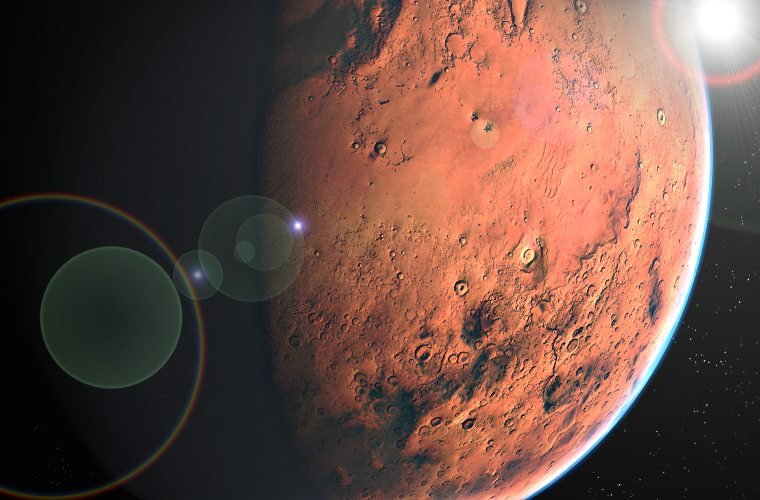Mars is half the size of Earth and 1.5 times farther than Earth is from the Sun. Its surface gravity is a third of Earth’s 1 g, making it an excellent platform for breaking world records in long jump and high jump at a future Martian Olympics. Of course, this “track and field” event will have to occur in a pressurized indoor stadium because the outdoor atmospheric pressure is only 0.6% of that on Earth.
Elders often say, “life was better in the good old days.” This definitely holds true for Mars. Early in its history, Mars had a substantial atmosphere that supported liquid water and served as a fertile ground for life.
The Perseverance Rover, launched by NASA on July 30, 2020, is seeking signs of ancient life on Mars and collecting samples of Martian rocks and regolith for a possible return to Earth. This will not be the first time that Martian rocks made it to Earth. One of them, the meteorite ALH84001, was never heated to a temperature higher than 40 degrees Celsius during its ejection from Mars and landing on Earth, based on its magnetic properties. This summer, the heatwave in Europe reached record temperatures higher than that, implying that early Martian life could have survived the trip to Earth inside rocks like ALH84001. If life first emerged on Mars and then delivered to Earth, we are all Martians. Under these circumstances, athletes are unnecessarily stressing their bodies in Earth’s gravity and should aspire to return back to the weaker gravity of their planet of origin.
What went wrong on Mars? Data from the Mars Reconnaissance Orbiter implies that Mars was rippled with rivers and ponds of water about 2.5 billion years ago. NASA’s MAVEN Orbiter presented evidence that Mars lost its atmosphere around that time. This highlights an intriguing timing coincidence. At around the same time that Mars dried up, the Earth’s atmosphere was enriched with Oxygen by cyanobacteria. Is this timing coincidence a random occurrence, or was there a common causal connection between the drastic atmospheric changes on these neighboring planets?
One possibility is that both atmospheric events were triggered by a giant solar storm that ripped apart the Martian atmosphere because it was only loosely bound by the weak Martian gravity. Perhaps the same storm also triggered a major change in the Earth’s atmosphere and induced conditions that promoted the production of oxygen by cyanobacteria. The complex forms of life that eventually led to our existence would have never occurred without the dramatic increase in the abundance of oxygen in the Earth’s atmosphere. If the two atmospheric events had a common trigger, the development of complex life on Earth was intertwined with the demise of primitive life on Mars. This gives historic significance to establishing a sustainable human base on Mars. It will restore the glory of complex life to a planet whose primitive life was never allowed to blossom to complexity as it was decimated by an existential catastrophe.
Let us pause for a moment of solidarity with all forms of Martian life that were extinguished prematurely.
This might not be the only timing coincidence that allowed us to exist. Taking a more global perspective, the Milky Way galaxy appears to be rare relative to most star-forming galaxies in the Universe. Our galaxy did not encounter a major merger with a comparable size galaxy since the Sun was born 4.6 billion years ago. Such a merger would have triggered an existential risk, as it would have fed the central black hole of the merger remnant with gas. For a supermassive black hole, the brilliant X-ray and UV emission from the resulting quasar could have sterilized life on Earth, as shown in a paper that I wrote with my former postdoc, John Forbes. Hence, the progression of complex life on Earth could have been halted by a catastrophe of cosmic proportions.
Let us pause for a moment of cosmic silence in remembrance of all the civilizations wiped out by the quasars we solemnly observe in the sky.
As for Mars, the future of the Milky Way will be very different from its past. Within a few billion years, the Milky Way, which was lucky to avoid major mergers for a long while, is destined to merge with its sister galaxy, Andromeda, whose dark matter halo is already touching the edge of the Milky Way halo. The two disk galaxies are on a collision course at a speed of 110 kilometers per second. In 2006, I wrote a paper with my former postdoc, T.J. Cox, where we simulated the collision and dubbed the merger product “Milkomeda.” In a few billion years, the Sun will be tossed away from its current orbit. The surrounding stars will no longer be concentrated in a thin strip of an edge-on disk but scattered all over the night sky – as appropriate for a football-shaped elliptical galaxy.
Here’s hoping that by the time the merger of the Milky Way with Andromeda occurs, our space vehicles will carry humans to safe destinations well beyond Mars. Irrespective of how far we reach, we will always remember the delicate circumstances that enabled our fragile existence. Life is hard work, but luck helps.
Avi Loeb is the head of the Galileo Project, founding director of Harvard University’s – Black Hole Initiative, director of the Institute for Theory and Computation at the Harvard-Smithsonian Center for Astrophysics, and the former chair of the astronomy department at Harvard University (2011-2020). He chairs the advisory board for the Breakthrough Starshot project, and is a former member of the President’s Council of Advisors onScience and Technology and a former chair of the Board on Physics and Astronomy of the National Academies. He is the bestselling author of “Extraterrestrial: The First Sign of Intelligent Life Beyond Earth” and a co-author of the textbook “Life in the Cosmos”, both published in 2021.

